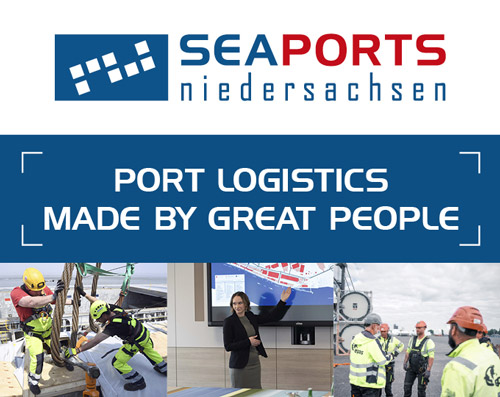How the energy supply will develop in the coming weeks and months is unclear. What is certain, however, is that the German seaports will play an important role in what is to come. This is because the now urgently needed terminals will be built right here – initially for importing LNG and, in future, for green gas.
In the medium term, the focus will then shift, as the energy mix will increasingly be dominated by renewable energies. This means biogas and, in particular, wind power and photovoltaics. “What’s important here is that we build the infrastructure for landing LNG today to make it suitable for green gas tomorrow,” explains Christian Budde, press officer at the Lower Saxony Ministry for the Environment, Energy, Building and Climate Protection. “After all, we will always need to import green gas, regardless of what is going on in the world.”
Short-term mobile, permanent facilities in the future
Two locations in Lower Saxony, Wilhelmshaven and Stade, offer good conditions for storing liquefied natural gas (LNG), imported by ship in mobile facilities and for regasifying it for further use. By the middle of next year, two such FSRUs could be moored in Wilhelmshaven as part of projects by Uniper and the Wilhelmshaven-based company Nord-West Oelleitung (NWO). Long-distance natural gas operator Open Grid Europe’s (OGE) connection pipeline could provide a transport capacity of 15 to 20 bcm by the end of 2022, and another from NWO with a capacity of 4 bcm by the end of 2023.
Besides the floating plants, there are other projects for permanent facilities, including a project by Belgian company Tree Energy Solutions (TES). However, this is primarily about Europe’s first large-scale green energy hub, which will produce and trade sustainable and low-cost carbon neutral energy and will be operational for green gas from 2027. In the short term, however, the facility can also be used as an LNG terminal. Furthermore, up to 10 bcm of green ammonia could be landed by 2025 as part of a project by Uniper. In Stade, there could be 13 bcm of LNG at the same time as part of the Hanseatic Energy Hub (HEH) project.
Long-term green hydrogen imports
The Institute for Solar Energy Research in Hamelin recently investigated the extent of this need for imports on behalf of the ministry. According to this study, imported green hydrogen will still account for 32 per cent of energy sources in 2050. The plants required for this would be feasible in Stade by 2024 and in Wilhelmshaven by 2025. “With the planned green gas-ready terminal in Wilhelmshaven, TES is pursuing this precise goal and can thus contribute to supplying Germany and Europe quickly with LNG in the face of the current energy crisis, and that in just a few years, with substantial quantities of green energy from overseas,” explains Olaf Lies, Lower Saxony’s Minister for the Environment and Energy.
TES is planning a green cycle in Wilhelmshaven. “Green hydrogen is produced from countries with very readily available renewable energy sources such as solar, wind and hydro power,” states Chief Technology Officer (CTO) Jens Schmidt. “CO₂ is then added to this to produce green (CH₄), which is used as an ‘energy carrier’ and transported to Wilhelmshaven by a specially designed fleet of ships.” There, the green (CH₄) can be converted back into green hydrogen, with the resulting CO₂ captured and returned by ship to the countries that produced it in a continuous closed loop system. “This way, we avoid greenhouse gas emissions by ensuring that the CO₂ never leaves the cycle,” Schmidt adds.
Potential for Bremen too
Importing green hydrogen also offers opportunities for Bremen’s ports, which are predestined to handle green hydrogen brought in by ship, says Bremen’s Senator for Science and Ports, Dr Claudia Schilling. “A study we commissioned entitled ‘Investigation into the development and establishment of a port-based hydrogen economy’ will give us further insights into the future-oriented transformation of our port economy.”
In future, the importance of ports is also likely to increase, especially regarding the expansion of offshore wind energy. In Lower Saxony, these are mostly Wilhelmshaven and Stade, but Emden, too. Moreover, the German Offshore Industry Centre Cuxhaven (DOIZ) is one of the largest offshore ports in Europe today. Ports that have not played a significant role in energy supply and domestic imports could also be repositioned. “In the course of the energy turnaround and the likely associated growth in the import of hydrogen or synthetic fuels, there are also new opportunities for Bremen’s ports to handle more green energy sources,” the senator
Logistics Pilot
The current print edition - request it now free of charge.






